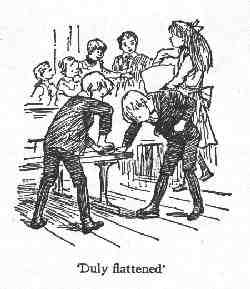
Ernest Shepard: Victorian School Clothes, the 1880s

Figure 1.-Ernest and a school mate flatten their hot cross buns--a
ritual only our Engish friends can understand. Ernest at about 7 years
wears wears a sailor suit. His mate a Norfolk jackjet and Eton collar.
Both boys wear kneepants and long stockings.
|
Ernest Shepard's lovely book, Drawn From Memory provides a delightful
window into Victorian boyhood. Included are several drawings giving a good idea
of what Ernest and his brother Cyril wore as boys. Ernest was born in 1879. His
brother appears a couple years older.
Much of the book is set about 1886 when Ernest was about 7 years old.
The deals primarily with home and family life.
There is one brief school scene suggesting what Ernest and his friends
wore to school as small boys. The school appears to be a private
coeducational school for young children before they begin their
preparatory school
at about 8 years of age. British preparatory and public (inthe typical
stange English way public schools means private) schools in the
1880s were beginning to standardize the ages at whuch they accepted
students. Earlier public schools at accepted quite young children. Public
schools were, however, very rough places unsuitable for younger children.
Some public schools set up their own prepatatory schools for the younger boys.
School masters, clerics, and others founded small schools for the expressed
purpose of preparing younger children for entry to public schools, in many cases these
were boarding schools. Other schools were established for even younger
children. These were local day schools and unlike the new preparatory and
older public schools, were often coeducational.
Britain has a long history of school uniforms which have infuenced
school atire around the worold. Public school required uniforms for
centuries, although the styles we generally preceive asvBritish school
uniforms appeared in the late 19th cebntury, about the time period
covered by Shepard. The new preparatory schools followed the example
of the public schools and required uniforms.
The day schools for younger
children, like the one Ernest describes, generally did not require
uniforms--although they now often do. The children simply wore their
ordinary clothes. Shepard does not discuss his school clothes. The
drawing he provides shows in his blue surge or wool sailor suit with knee
pants and long stockings. At least two of the boys wear Eton collars.
Stiff Eton collars. At the time, many preparatory
and public schools required the boys to wear Eton collars as part of their school uniforms.
What Shepard does remenber were the hot cross buns the children brought each morning. For some stange reason, it was fashionable for the boys to
flatten their buns. The boys in the above drawing are pressing them with their hands. Apparently other methods wre sitting on them or stomping on them!
I am not sure what school older brother Cyril attended or what he wore. It is possible
he attended a prepartaory school. Perhaps even a boarding school, although
in Shepard's book, Cyril always seems to be around. The Eton collar he
wears may be a reflectiion of his preparatory school uniform. One sad

Figure 2.--This photograph taken at a private school for younger children
about the turn of the century (about 15-20 years after Ernest attended one
of these schools) gives an idea how the children dressed.
|
matter to relate, after reading Shepard'd book, you feel so attached to
the boys. Cyril was unfoirtunately killed, like so many of his countrymen,
in World War I. It is hard for Americans to comprehend the enormity of the
slaughter in World War I (1914-18). One indicator are the books located in countless
English churches down to the smallest village church. They are massive books,
in many cases looking like those unabridged dictionaries in libraries.
Thet include name after name of the men killed in the war. Each day a
page is turned in their memmory. The social cionsequences of the slaughter
still affect us to this day. One of the countless impacts was a thorough,
pefvasive change in fashion, including boys' fashions. Compare, for example,
differences between the fashions in the 1900s,
the 1910a, and the 1920s.
Christopher Wagner
histclo@lycosemail.com
Navigate the Ernest Shepard pages
[Return to the Main Shepard page]
[Earnest's dresses]
[Earnest's Fautleroy suits]
[Earnest's sailor suits]
[Earnest's school]
Navigate the Boys' Historical Clothing Website
[Introduction]
[Chronology]
[Clothing styles]
[Countries]
[Biographies]
[Bibliographies]
[Activities]
[Contributions]
[Boys' Clothing Home]
Last updated: September 18, 1998



